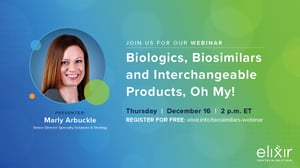With rising drug costs, we’re all looking for ways to reduce out-of-pocket spend without sacrificing quality. Generic medications have long been a way to manage costs, but decades ago, when the first generics for blockbuster drugs started entering the market, they weren’t welcomed with open arms.

These were all questions that we fielded at the pharmacy in those early days. There was an immediate perception of a lack of efficacy to generics simply because they were less expensive. And we are talking about traditional drugs, such as cholesterol medications, antidepressants, antibiotics and others. Now, decades later, the pendulum has swung the other direction, and generics in the traditional drug space are widely used.[1]
We are now facing a similar uphill battle with the adoption of biosimilars in the specialty drug space. Think of the stigma associated with generic usage from decades ago in the traditional drug space and add to that the additional concerns for drugs used to treat complex conditions, such as cancer, autoimmune disorders, multiple sclerosis and various rare diseases, and everything that these patients are experiencing prior to even going on therapy.
With more complex drugs comes a more complex acceptance. Additional fears of switching to a less expensive alternative of a life-sustaining drug only compounds the resistance and perceived lack of efficacy associated with generic and biosimilar alternatives.
Enter the need for education!
The Key Differences in Drugs
 There are basically two types of drugs—small molecule drugs and large molecule (aka, “biologic”) drugs.[2] These two types of drugs have vastly different characteristics. They are made completely differently. They look completely different. The manufacturing and reproduction of each type is completely different.[3] While a vast oversimplification, think of these differences using these analogies: (1) the difference between building a doghouse vs. the Empire State building, where small molecule drugs are the doghouse and large molecule drugs are the Empire State building, or (2) the difference between constructing an abacus vs. J.A.R.V.I.S. artificial intelligence from the Ironman movie series. It’s also important to note that when we speak of direct FDA alternatives to each type, we use the term “generic” for small molecule drugs and “biosimilar” for large molecule drugs.
There are basically two types of drugs—small molecule drugs and large molecule (aka, “biologic”) drugs.[2] These two types of drugs have vastly different characteristics. They are made completely differently. They look completely different. The manufacturing and reproduction of each type is completely different.[3] While a vast oversimplification, think of these differences using these analogies: (1) the difference between building a doghouse vs. the Empire State building, where small molecule drugs are the doghouse and large molecule drugs are the Empire State building, or (2) the difference between constructing an abacus vs. J.A.R.V.I.S. artificial intelligence from the Ironman movie series. It’s also important to note that when we speak of direct FDA alternatives to each type, we use the term “generic” for small molecule drugs and “biosimilar” for large molecule drugs.
The FDA Regulation Process
Rest assured that the FDA has done its due diligence by creating the appropriate approval pathways for small molecule drugs and their corresponding generics, in addition to large molecule “biologics” and their corresponding biosimilars.
When referring to biologic drugs and their corresponding alternatives there are three main terms to remember:[3]
- Reference Product – The originator product, already approved by the FDA, against which a proposed biosimilar product is compared
- Biosimilar Product – A biological product that is highly similar and has no clinically meaningful differences from an existing FDA-approved reference product
- Interchangeable Product – An interchangeable product is a biosimilar product that meets additional requirements
A biosimilar is not required to have interchangeability status to be FDA approved, and of the biosimilars on the market today in the U.S., most do not have interchangeability status.[3] But the word “interchangeable” does help to ease doubts around use of a biosimilar. Is it a gamble for the biosimilar manufacturer not to seek interchangeability status? Sure. Would it help with the perceived lack of efficacy? Probably. Does it cost the manufacturer more to gain this status? Oh yeah. But this is why we need more education. Without interchangeability status for most of these products, it's important to educate prescribers, patients and payers on why biosimilars are still clinically appropriate to treat the same conditions as the reference product, as outlined in the FDA indications for use.
Promise vs. Performance vs. Potential
Despite the number of biosimilars that have been approved in the U.S., only about 70% have reached the market.[4] This is largely due to patent litigations and court settlements between the reference product and biosimilar product manufacturers.
One of the largest barriers to use of biosimilars has simply been a lack of education. We are a nation centered around brand loyalty, perceived value and bias. For those first biosimilars that entered the market early on in 2016, there was initial prescriber hesitation and a slow rate of adoption. However, as more biosimilars have launched in 2018 and into 2019, mostly in the provider-administered segment, the adoption rate has significantly increased.[5] This is largely due to the prescriber community learning and understanding how biosimilars can be used in their practice.
Now we are on the cusp of seeing more self-administered biosimilars in the not-so-distant future—insulins and Humira® just to name a few. With some estimates indicating that biosimilars in the U.S. could produce a savings of around $54 billion from 2017 to 2026, it is even more critical than ever that we get more comfortable with what biosimilars are to ensure patients have access to more affordable treatment options.[6]
‘Tis the Season to Talk Biosimilars!
Education is power. We fear what we don’t know or don’t understand. We’re seeing living proof of that today as we navigate through this pandemic! So, let’s start breaking it down into digestible pieces that we can understand. Join us for an upcoming webinar December 16 at 2 p.m. ET where we will bust through myths, break down barriers and learn about the following benefits of biosimilars:
- Less Money – Biosimilars, like generics, bring more competition and, as a result, lower costing treatment options in an already costly space.
- No Fear in Switching – Switch studies have proven that a patient can switch from the reference product to the biosimilar without losing treatment efficacy. Routine, dose, administration and delivery stay the same. All that’s needed is a new prescription.
- Peace of Mind – The FDA has built a rigorous approval process and standards for biosimilars, showing they are safe, effective and have no clinically meaningful differences to reference products.
- Educational Support – Educational support is available online through the FDA’s website at gov/drugs/therapeutic-biologics-applications-bla/biosimilars.
- Additional Savings – Copay assistance is available for biosimilar products.
- More Treatment Options – Widespread availability of biosimilars means more patients can have better access to treatments they need, creating a value impact on patients’ lives.
[1] IQUVIA Institute (2018). Medicine Use and Spending in the U.S. https://www.iqvia.com/-/media/iqvia/pdfs/institute-reports/medicine-use-and-spending-in-the-us-a-review-of-2017-and-outlook-to-2022.pdf?_=1531930534761.
[2] Makurvet F.D. (2021). Biologics vs. small molecules: Drug costs and patient access. https://reader.elsevier.com/reader/sd/pii/S2590098620300622?token=77FD6374AAC60304C93A56A21BE9C0D0F1E8894E28121361C6EF739F8E8879D90C47E40926277F2A99D68945F5EC686E&originRegion=us-east-1&originCreation=20211119174643.
[3] U.S. Food & Drug Administration. Biosimilars. https://www.fda.gov/drugs/therapeutic-biologics-applications-bla/biosimilars.
[4] IPD Analytics Biosimilar Launch Report. Accessed August 9, 2021.
[5] Fein, A.J. (2020). The Booming Biosimilar Market of 2020. Drug Channels. https://www.drugchannels.net/2020/10/the-booming-biosimilar-market-of-2020.html.
[6] Mulcachy, A.W.; Hlavka, J.P.; Case, S.R. (2018). Biosimilar Cost Savings in the United States. Rand Corporation. https://www.rand.org/pubs/periodicals/health-quarterly/issues/v7/n4/03.html.



